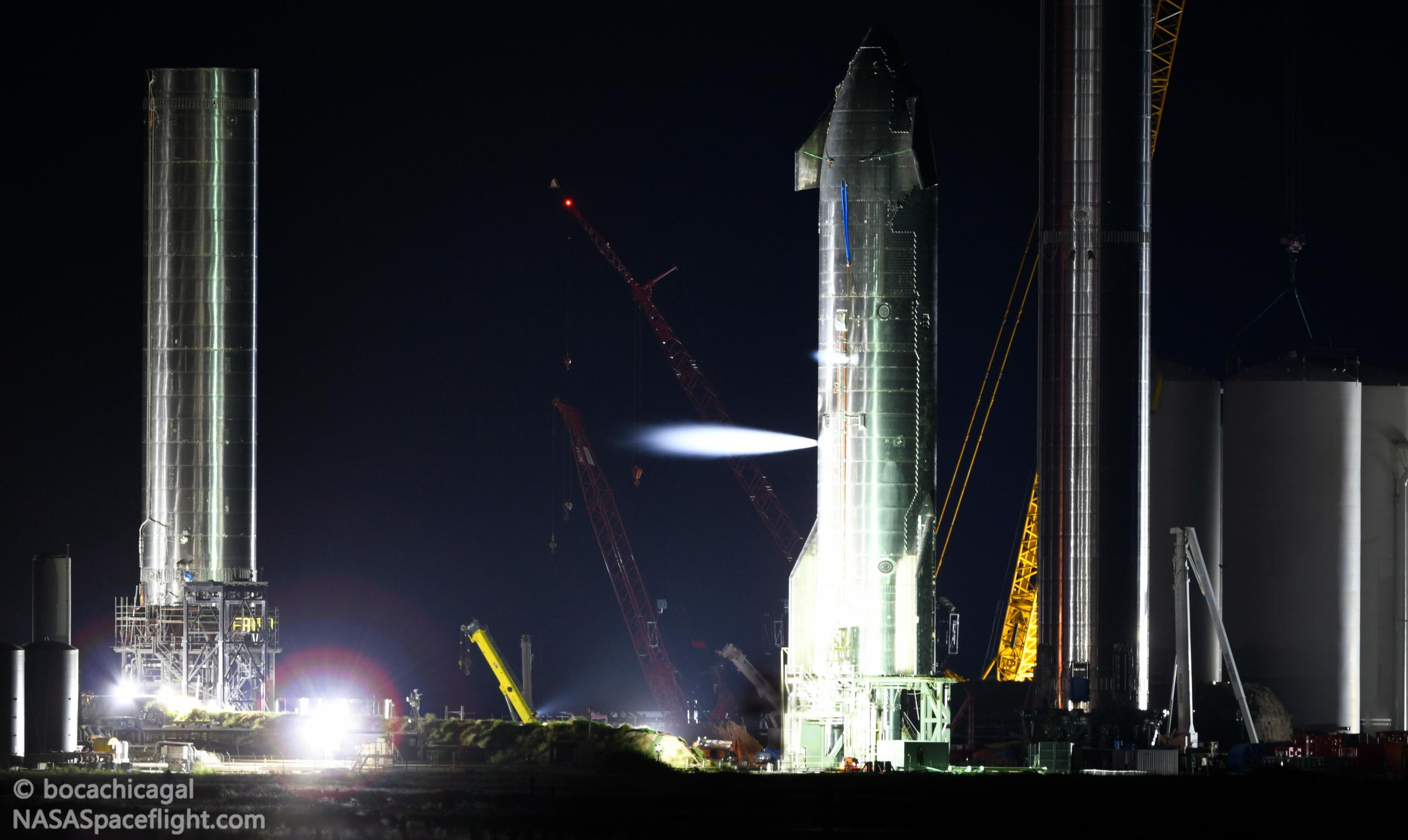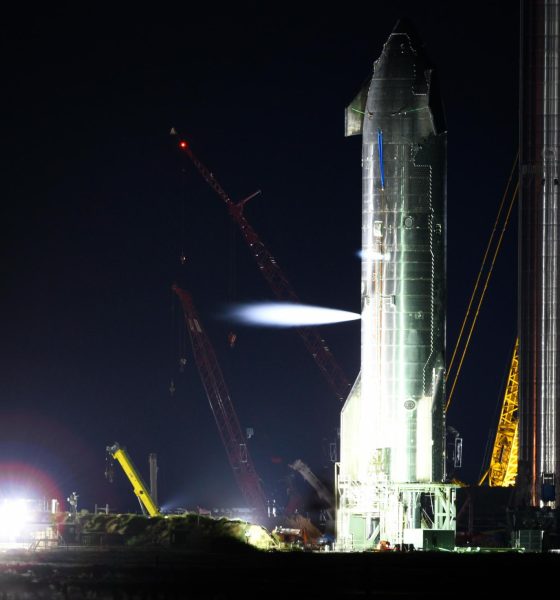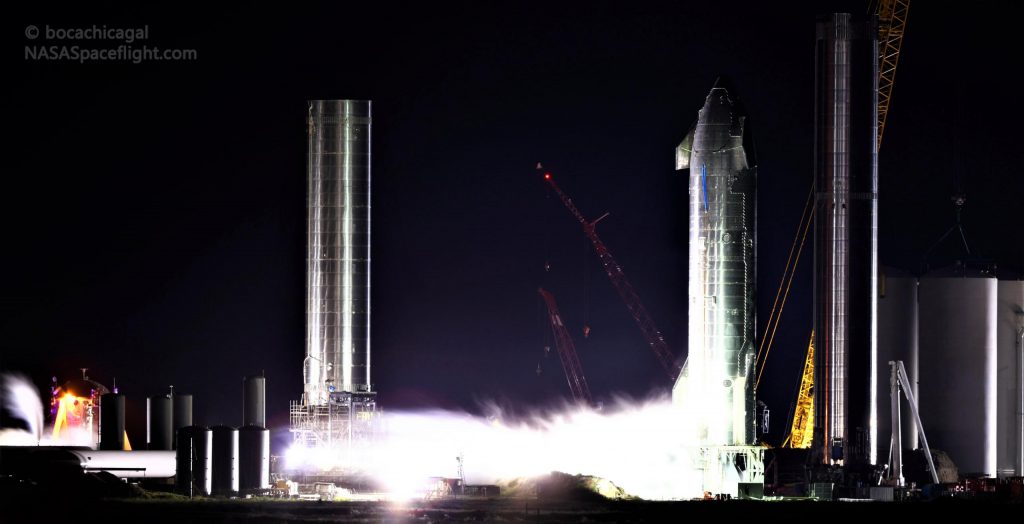

News
SpaceX’s orbital Starship prototype sheds tiles, comes to life during first tests
After weeks of mostly invisible – albeit slow and steady – work at Starbase’s suborbital launch and test facilities, SpaceX has finally kicked off the first orbital Starship prototype’s first test campaign.
Almost two months ago, Starship 20 (S20) departed the factory it was built in for the first time and was rolled a few miles down a South Texas highway to Starbase’s nascent orbital launch site. There, SpaceX briefly installed Ship 20 on top of Super Heavy Booster 4 (B4) – an important first and one done with the same ship and booster pair CEO Elon Musk says could eventually support the rocket’s inaugural orbital launch attempt. Mere hours after that August 6th photo opportunity and fit test, Ship 20 was rolled back to the Starbase build site for another week of work before again returning to the launch site.
This time around, Starship S20 headed for one of two suborbital launch and test stands and ultimately spent the better part of the next six weeks sitting in place as workers swarmed around the 50m (~165 ft) tall spacecraft and upper stage to prepare it for the next steps. In theory, those steps were simple enough, beginning with the completion of two basic qualification tests – the same tests that a half-dozen prototypes preceding Ship 20 completed without issue.

Effectively SpaceX’s first Starship or Super Heavy test of any kind in more than two months, it thankfully didn’t take long for things to get interesting. Before the pad had even been cleared of the last few remaining workers, Starship S20 violently shed a good dozen or so fragile heat shield tiles. CEO Elon Musk quickly confirmed speculation that Starship S20 had effectively jetted the tiles off its nose during a brief test of high-pressure cold gas maneuvering thrusters, coincidentally around the same time as SpaceX began to pressurize the rocket for its first tests.


Going into what was believed to be Starship S20’s first ambient-temperature pressure test and cryogenic proof test, the loss of some heat shield tiles was almost universally expected. In a structure as large as Starship, even just the thermal contraction of steel at supercool temperatures (and expansion as it warms back up) could change the rocket’s diameter an inch or so, potentially causing tiles to scrape or press against each other. About the size of a dinner plate and the thickness of an average paperback book, Starship’s ceramic heat shield tiles have proven to be very fragile, with dozens routinely chipping, cracking, and shattering during and after installation on Ship 20.
One unique (and no less unproven) aspect of Starship is SpaceX’s decision to mount its heat shield directly to the thin steel propellant tanks and skin that make up the rocket’s entire airframe. SpaceX’s first stab at the problem involves studs/pins welded – by robot – directly to the exterior of Starship’s tanks and skin. By embedding small metal plates inside each cast tile, they can be easily installed by aligning the tile and pressing it against each set of three barb-like pins, which then irreversibly lock in place. Over most of Starship’s hull, SpaceX then tacks on blankets of off-the-shelf ceramic wool insulation before tiles are installed on top of that steel and blanket sandwich. Compared to the Space Shuttle and Russia’s Buran, the only other orbital spacecraft to fly with non-ablative heat shields, Starship’s thermal protection system (TPS) is incredibly simple. Of course, the challenges imposed on heat shields by mechanical stresses during launch/landing, orbital reentry, and a need for rapid reusability are anything but simple.
As such, to see tiles blown off Starship S20 by cold gas maneuvering thrusters that were simply placed too close to adjacent TPS was an unexpected route to an expected outcome. During Monday’s nine-hour test window, SpaceX appeared to partially or fully pressurize Starship S20 at ambient temperatures before aborting a cryogenic proof test either before or just after it began. While an ambient-temperature proof was the easier of the two tests on the docket, it’s still encouraging to see no obvious tile loss caused by the actual mechanical stresses involved in the test.
Most importantly, compared to losing dozens of tiles to regular mechanical or thermal stresses, fixing an issue with thruster impingement is much easier and should only require a few design tweaks to one specific Starship component. The real nail-biting moments will come during Starship S20’s seemingly imminent cryogenic proof and static fire debuts, major TPS issues during either of which could necessitate vehicle-wide design changes and cause delays.

With any luck, whatever forced SpaceX to abort Starship S20’s first cryogenic proof test can be easily rectified, opening the door for additional attempts. Two more test windows are scheduled later this week from 5pm to 11pm CDT on Tuesday and Wednesday. Rewatch today’s brief testing below.

Elon Musk
Tesla’s Elon Musk: 10 billion miles needed for safe Unsupervised FSD
As per the CEO, roughly 10 billion miles of training data are required due to reality’s “super long tail of complexity.”

Tesla CEO Elon Musk has provided an updated estimate for the training data needed to achieve truly safe unsupervised Full Self-Driving (FSD).
As per the CEO, roughly 10 billion miles of training data are required due to reality’s “super long tail of complexity.”
10 billion miles of training data
Musk comment came as a reply to Apple and Rivian alum Paul Beisel, who posted an analysis on X about the gap between tech demonstrations and real-world products. In his post, Beisel highlighted Tesla’s data-driven lead in autonomy, and he also argued that it would not be easy for rivals to become a legitimate competitor to FSD quickly.
“The notion that someone can ‘catch up’ to this problem primarily through simulation and limited on-road exposure strikes me as deeply naive. This is not a demo problem. It is a scale, data, and iteration problem— and Tesla is already far, far down that road while others are just getting started,” Beisel wrote.
Musk responded to Beisel’s post, stating that “Roughly 10 billion miles of training data is needed to achieve safe unsupervised self-driving. Reality has a super long tail of complexity.” This is quite interesting considering that in his Master Plan Part Deux, Elon Musk estimated that worldwide regulatory approval for autonomous driving would require around 6 billion miles.
FSD’s total training miles
As 2025 came to a close, Tesla community members observed that FSD was already nearing 7 billion miles driven, with over 2.5 billion miles being from inner city roads. The 7-billion-mile mark was passed just a few days later. This suggests that Tesla is likely the company today with the most training data for its autonomous driving program.
The difficulties of achieving autonomy were referenced by Elon Musk recently, when he commented on Nvidia’s Alpamayo program. As per Musk, “they will find that it’s easy to get to 99% and then super hard to solve the long tail of the distribution.” These sentiments were echoed by Tesla VP for AI software Ashok Elluswamy, who also noted on X that “the long tail is sooo long, that most people can’t grasp it.”
News
Tesla earns top honors at MotorTrend’s SDV Innovator Awards
MotorTrend’s SDV Awards were presented during CES 2026 in Las Vegas.

Tesla emerged as one of the most recognized automakers at MotorTrend’s 2026 Software-Defined Vehicle (SDV) Innovator Awards.
As could be seen in a press release from the publication, two key Tesla employees were honored for their work on AI, autonomy, and vehicle software. MotorTrend’s SDV Awards were presented during CES 2026 in Las Vegas.
Tesla leaders and engineers recognized
The fourth annual SDV Innovator Awards celebrate pioneers and experts who are pushing the automotive industry deeper into software-driven development. Among the most notable honorees for this year was Ashok Elluswamy, Tesla’s Vice President of AI Software, who received a Pioneer Award for his role in advancing artificial intelligence and autonomy across the company’s vehicle lineup.
Tesla also secured recognition in the Expert category, with Lawson Fulton, a staff Autopilot machine learning engineer, honored for his contributions to Tesla’s driver-assistance and autonomous systems.
Tesla’s software-first strategy
While automakers like General Motors, Ford, and Rivian also received recognition, Tesla’s multiple awards stood out given the company’s outsized role in popularizing software-defined vehicles over the past decade. From frequent OTA updates to its data-driven approach to autonomy, Tesla has consistently treated vehicles as evolving software platforms rather than static products.
This has made Tesla’s vehicles very unique in their respective sectors, as they are arguably the only cars that objectively get better over time. This is especially true for vehicles that are loaded with the company’s Full Self-Driving system, which are getting progressively more intelligent and autonomous over time. The majority of Tesla’s updates to its vehicles are free as well, which is very much appreciated by customers worldwide.
Elon Musk
Judge clears path for Elon Musk’s OpenAI lawsuit to go before a jury
The decision maintains Musk’s claims that OpenAI’s shift toward a for-profit structure violated early assurances made to him as a co-founder.

A U.S. judge has ruled that Elon Musk’s lawsuit accusing OpenAI of abandoning its founding nonprofit mission can proceed to a jury trial.
The decision maintains Musk’s claims that OpenAI’s shift toward a for-profit structure violated early assurances made to him as a co-founder. These claims are directly opposed by OpenAI.
Judge says disputed facts warrant a trial
At a hearing in Oakland, U.S. District Judge Yvonne Gonzalez Rogers stated that there was “plenty of evidence” suggesting that OpenAI leaders had promised that the organization’s original nonprofit structure would be maintained. She ruled that those disputed facts should be evaluated by a jury at a trial in March rather than decided by the court at this stage, as noted in a Reuters report.
Musk helped co-found OpenAI in 2015 but left the organization in 2018. In his lawsuit, he argued that he contributed roughly $38 million, or about 60% of OpenAI’s early funding, based on assurances that the company would remain a nonprofit dedicated to the public benefit. He is seeking unspecified monetary damages tied to what he describes as “ill-gotten gains.”
OpenAI, however, has repeatedly rejected Musk’s allegations. The company has stated that Musk’s claims were baseless and part of a pattern of harassment.
Rivalries and Microsoft ties
The case unfolds against the backdrop of intensifying competition in generative artificial intelligence. Musk now runs xAI, whose Grok chatbot competes directly with OpenAI’s flagship ChatGPT. OpenAI has argued that Musk is a frustrated commercial rival who is simply attempting to slow down a market leader.
The lawsuit also names Microsoft as a defendant, citing its multibillion-dollar partnerships with OpenAI. Microsoft has urged the court to dismiss the claims against it, arguing there is no evidence it aided or abetted any alleged misconduct. Lawyers for OpenAI have also pushed for the case to be thrown out, claiming that Musk failed to show sufficient factual basis for claims such as fraud and breach of contract.
Judge Gonzalez Rogers, however, declined to end the case at this stage, noting that a jury would also need to consider whether Musk filed the lawsuit within the applicable statute of limitations. Still, the dispute between Elon Musk and OpenAI is now headed for a high-profile jury trial in the coming months.








